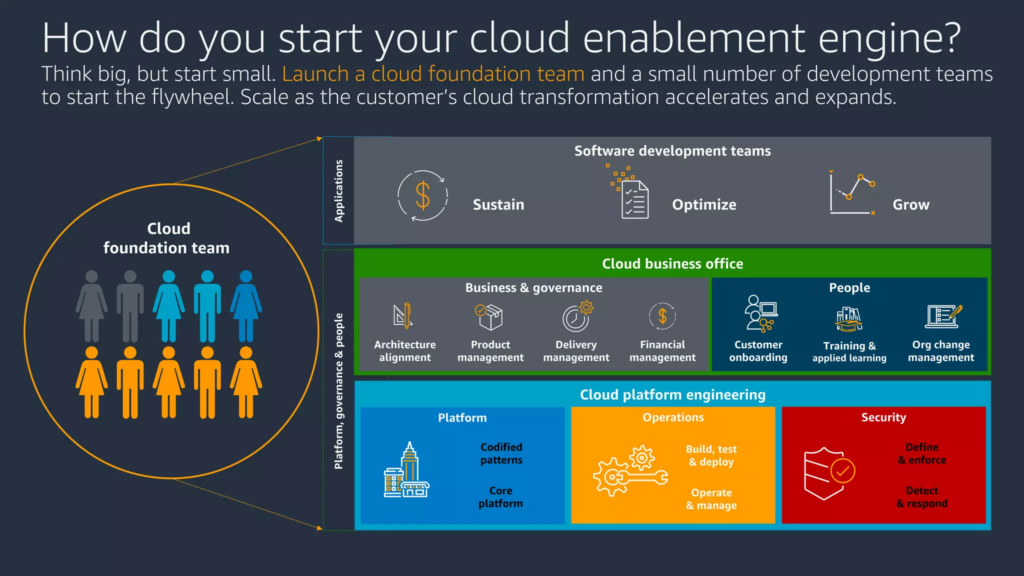

As an AWS partner, Tech Reformers, strives to help organizations to innovate with the cloud. The goal is innovation while improving information technology (IT) in six areas: operational excellence, security, reliability, performance efficiency, cost optimization, and sustainability, The 6 Pillars of the AWS Well-Architected Framework. The Cloud Enablement Engine (CEE) is a guiding process bringing together the business and technology teams and, in education, the instructional team. The goal is a digital transformation moving from an on-premises operating model to a Cloud Operating Model (COM) to achieve district goals.
Once dubbed a “Cloud Center of Excellence,” Philip Potloff, the Head of Enterprise Strategy at AWS, describes it in Challenging Conventional Wisdom About How to Build a Cloud Center of Excellence as
“a multi-disciplinary team that is assembled to implement the governance, best practices, training, and architecture needed for cloud adoption in a manner that provides repeatable patterns for the larger enterprise to follow.”
He cites research and experience that shows the best team is not a well-honed IT team, a successful project team, or an egalitarian mix of staff. Transformation enterprisewide is more likely when there is a mix of “A-team” players with success in IT and project management working with “new blood” that brings in a supply of new ideas relevant to the district.
The team must have top-down support from an influential executive sponsor. In school districts, this would be the superintendent or other cabinet leader. A key pattern for success is to have not just an executive sponsor but an Executive Cloud Steering Committee that includes senior executives that are not on the CEE. They serve as the North Star and ensure the CEE is in support of district strategy and goals.
The CEE is ready to go upon completion of the 5 kick-off activities:
- Build the team
- Train and coach
- Pilot projects
- Architect for the cloud
- Operate in the cloud.
Build the Team
The initial team member may be the CIO, CTO, or director in IT with hands-on experience who knows the capabilities of AWS but also has the political capital to bring in business leaders aboard with the CEE. With other leaders on board, the goal is to build a ‘two-pizza” team, small enough to share a couple of pizzas. To start, less is more. Technology is the team focus initially. Some successful organizations have also had a larger cross-functional Cloud Steering Committee that ensures progress, removes roadblocks, and helps with decision-making that affects the organization.
Train and Coach
Initial members beyond the leader may include infrastructure, networking, and operations which will be cloud leaders. Core member training is the next step. Creating learning paths and training in cooperation with Human Resources creates a process for extending cloud adoption. The CCE team leverages the AWS Well-Architected framework and will become familiar with AWS reference architectures, AWS Quick Starts, and AWS Solutions. Successful CEE implementations include AWS training for the entire organization. At AWS, for example, every employee becomes a Certified Cloud Practioner. Districts could have a Cloud 101 that covers the core of transforming with the Cloud.
IT probably has an existing Project Management Office (PMO) or project management team. This team is critical to the success of the CEE. They are closely aligned with the business verticles and should be armed with agile project management skills. Now a Cloud PMO, the team can create a manifesto to guide decision-making for project onboarding, process changes, role definitions, organizational changes, cloud architecture, and cultural change. Communication skills are the key to bringing the organization along the cloud journey.
Pilot Projects
The CEE then develops pilot projects in a lab environment. It’s important to keep the sponsor and senior leadership engaged in the progress and aware of the pilot projects. What pilot may have an impact beyond the IT team? Identify pilots that could improve the business, have the potential to save money, would increase reliability, or can deliver on a business need.
Architect for the Cloud
Before going live with AWS, it’s important to architect the AWS environment for the enterprise. AWS must be integrated into the fabric of the technology environment. Plan on using Organizations or Control Tower. Build a multi-account architecture with unified security controls, centralized billing, and governance. Integrate with an existing Identity Provider like Active Directory to provide familiar login credentials and account management.
Operate in the Cloud
The Well-Architected pillar, Operational Excellence, focuses on people, not technology. The CEE should develop a Cloud Operating Model (COM). The COM may include infrastructure as code, code repositories and version control, monitoring, alerting, notifications and reporting, escalation policies, financial tracking and auditing, service deployment policies, and examination of opportunities for agile practices. This is important even if your district has few or no custom applications. The “Super Power” of the cloud is automation. So, even compute, storage, databases, and Commercial Off-The-Shelf Software (COTS Software) can all be deployed by code using, for example, Cloud Formation Templates and user data scripts.
With the 5 kick-off activities complete, the CEE moves into production and continuous improvement.

Kickoff and Continuous Improvement
With guidance from the executive sponsor, steering committee, and stakeholders, the CEE delivers early value. Like the pilots, identify projects to improve the business to save money, to increase reliability, or to deliver on a business need. An IT focus with financial and reliability benefits might be to move from tape or local disk backup to backup to Amazon S3. A project for educators may be to deploy Amazon AppStream 2.0 to enable Career and Technical Education (CTE) students to use high-end applications on any device. Or is there an application from the AWS Marketplace that could fit the need for, say, HR?
Striving for continuous improvement builds on early successes. Perform AWS Well-Architected Reviews on the new workloads and on potential legacy data center workloads. This builds the capacity of the team while driving the CEE forward. Organization-wide improvement can be achieved by leveraging early adopters to help others. A Community of Practice identifies and shares best practices not just to IT but to business units and other stakeholders.
Cloud Adoption is a journey, and the Cloud Enablement Engine: A Practical Guide provides prescriptive guidance. Following the CEE will enable a district to transform and innovate with the cloud. Additionally, information technology (IT) will improve in six areas: operational excellence, security, reliability, performance efficiency, cost optimization, and sustainability.